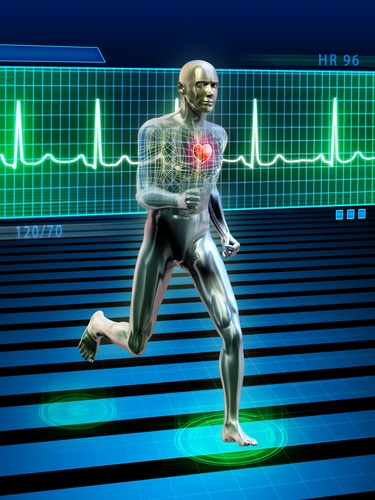
How Does Exercise Lower Blood Pressure?
Exercise reduces resistance in arteries so that blood can flow more freely. When you work out, blood flows more rapidly through your arteries. The shearing force of this increased movement stimulates cells along the inner walls of blood vessels called endothelial cells to produce a gas-like substance called nitric oxide. Nitric oxide expands and opens up blood vessels and reduces the resistance to blood flow. This lowers blood pressure.
Nitric oxide also explains why exercise lowers the risk of heart disease, heart attacks, and strokes. Once nitric oxide is produced, it’s stored in the heart and blood vessels in the form of nitrites, so it can be quickly converted back to nitric oxide. When you stop exercising, you lose this protection within a month of stopping and you’ll likely see your blood pressure go back up.
Other Ways to Increase Nitric Oxide Production
Nitric oxide is a good thing to have more of to control blood pressure and reduce the risk of heart disease and stroke. Aerobic exercise is one of the best ways to get its benefits, but it’s not the only one. Diet plays a role too. Green, leafy vegetables, especially spinach, are rich in nitrates and nitrites that blood vessels use to make nitric oxide. In addition, apples, beetroot juice, and dark chocolate contain flavonoids that boost nitric oxide production and protect against heart disease. These foods improve endothelial function or the way the inner lining of blood vessels respond to blood flow. When there’s plenty of nitric oxide around, blood vessels relax and blood pressure goes down.
While foods like green, leafy vegetables and chocolate improve endothelial function and nitric oxide production, fast foods cooked in a vat of fat have the opposite effect. A study published in the Journal of the American College of Cardiology showed that a single deep-fried meal cooked in reheated oil worsened endothelial function, creating conditions that can lead to heart disease and heart attacks. One more reason to eat your greens and avoid fast food restaurants.
The Bottom Line?
Exercising naturally boosts the amount of nitric oxide your blood vessels produce, which helps to lower blood pressure and protect against heart disease and stroke. Combine it with a healthy diet rich in green, leafy vegetables and other whole foods and you have a recipe for a healthy heart – naturally.
References:
Annals of Internal Medicine. April 2, 2002, vol. 136 no. 7 493-503.
Ann Intern Med. 2002;136:493-503.
Acta Physiol Hung. 2000;87(2):127-38.
Medscape.com. “Analysis of Recent Papers in Hypertension”
Emory Woodruff Health Sciences Center. “Exercise Protects the Heart Via Nitric Oxide”
Free Radic Biol Med. 2012 Jan 1;52(1):95-102. Epub 2011 Oct 1.
J Am Coll Cardiol, 1999; 33:1050-1055.
Related Articles By Cathe:
Types of Exercise That Lower Blood Pressure
Exercise and Hypertension: Can You Exercise Your Way to a Lower Blood Pressure?
Is Exercise as Good as Blood Pressure Medications for Lowering Blood Pressure?
Is High-Intensity Exercise Better for Lowering Blood Pressure Than Moderate-Intensity Workouts?
The Top Ten Things You Can Do to Lower Your Blood Pressure
6 Ways Eating Vegetables Lowers the Risk of Cardiovascular Disease

